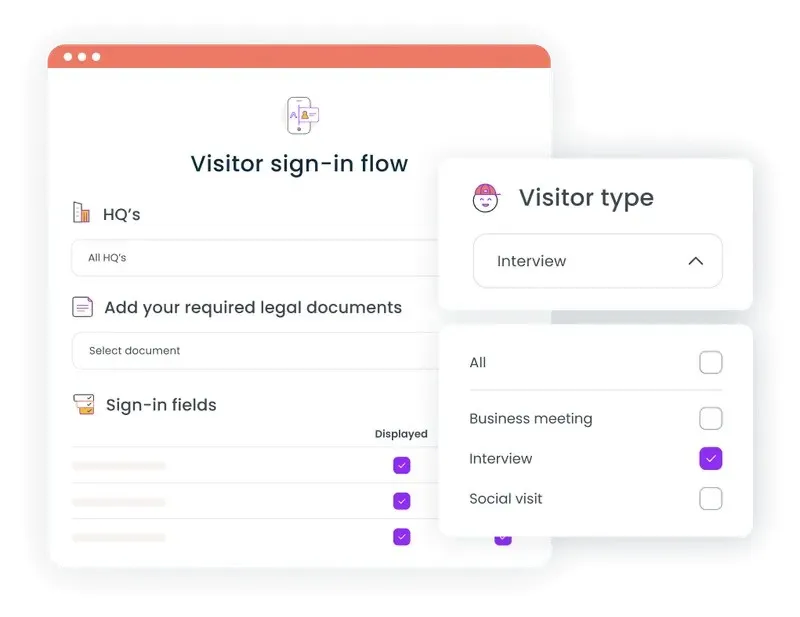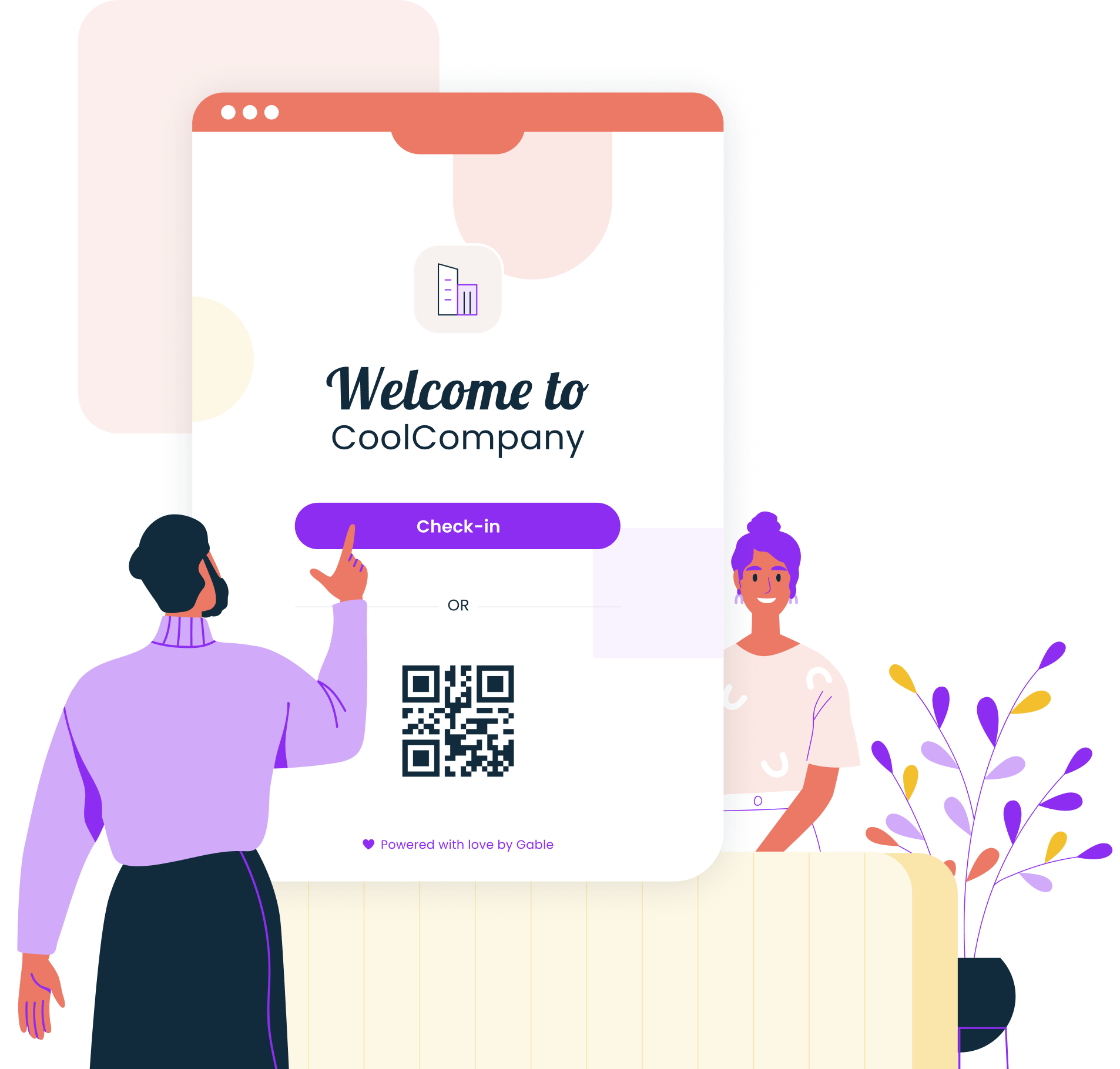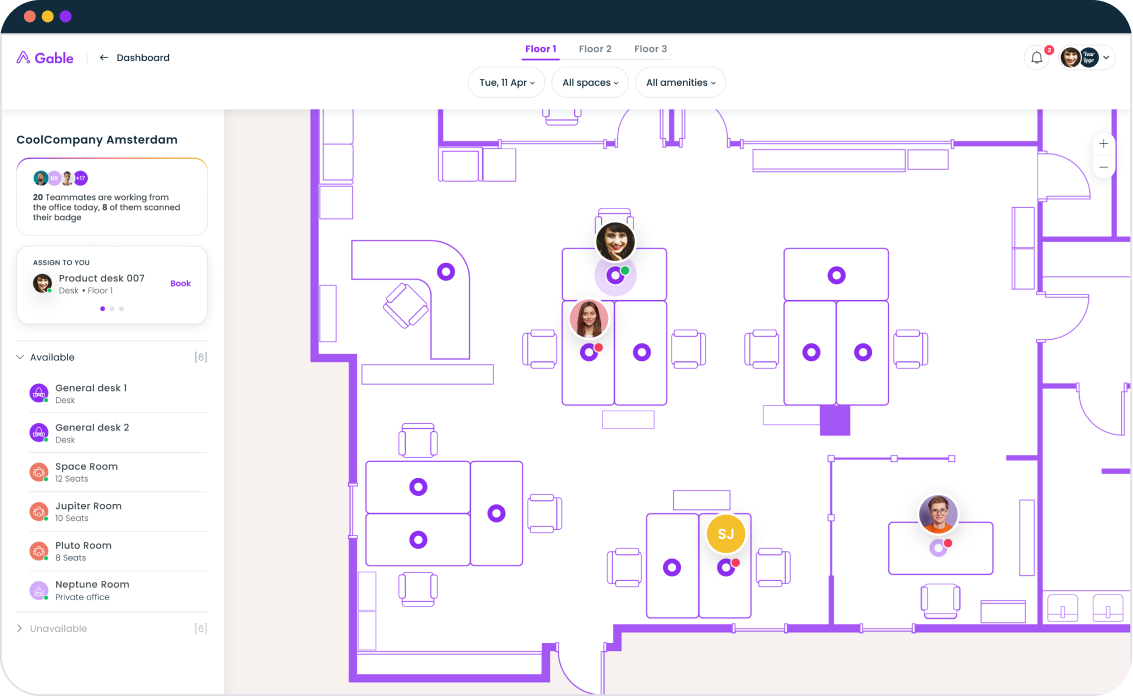Guest management (also known as visitor management) is the process of overseeing and controlling the visitor experience while maintaining workplace security and compliance. As organizations adopt flexible work models and distributed teams, effective guest management has become crucial for safeguarding people, property, and sensitive information.
What is guest management?
Guest management refers to the process of managing and tracking all visitors to your workplace, from the moment they arrive until they leave. This includes everything from visitor check-in procedures and identity verification to access control, host notifications, and departure tracking.
Modern guest management involves three core components:
- Physical security: Centralized control over who enters your facility, what type of guest access they have, and monitoring their movements throughout the building.
- Digital management: Automating workflows, eliminating manual tasks, storing visitor data securely, and providing real-time insights.
- Experience optimization: Creating a seamless, professional visitor experience that reflects your brand, company culture, and specific business needs.
Unlike paper-based visitor logs, today's guest management approach integrates technology, security protocols, and hospitality practices to create a holistic solution. The global visitor management system market is projected to grow at 11.7% CAGR through 2035, driven by increasing security requirements and demand for automated workplace solutions.
The goal is to create a strategic advantage by balancing security with hospitality, gathering valuable data about space usage, and supporting your organization's broader workplace strategy.
Why guest management matters for modern workplaces
Effective guest management has become a strategic necessity rather than just an operational requirement. Here's why it matters:
First impressions drive business outcomes
As soon as a guest arrives, they form an impression about your company. A smooth, professional check-in process signals that your organization is well-run, security-conscious, and values the visitor experience. This matters whether you're welcoming potential clients, interviewing job candidates, or hosting partners.
Security threats are evolving
Research shows that 36% of businesses experienced data breaches exceeding $1 million, up from 27% the previous year. Physical access control remains a critical component of overall security strategy, as unauthorized access can lead to data theft, intellectual property loss, or safety incidents.
Compliance requirements are increasing
Industries from healthcare to finance face strict regulations about visitor tracking, data protection, and emergency preparedness. Guest management systems help organizations maintain compliance by automatically logging visitor information, managing data securely, and providing audit trails when needed.
Workplace data provides strategic insights
Modern guest management systems generate valuable analytics about visitor patterns, peak usage times, and space utilization. This data supports decisions about office layouts, staffing levels, and real estate planning, which is crucial as organizations optimize their footprint in the hybrid work era.
Employee productivity benefits
Manual visitor management processes interrupt employees throughout the day. Market research firm IDC found that companies lose 20 to 30 percent of their revenue to inefficiencies every year. Automated guest management reduces these disruptions while ensuring visitors receive prompt attention.

Learn how Gable's visitor management solution creates secure, welcoming experiences while protecting your workplace from unauthorized access.
Learn more
Key challenges of guest management
Despite its importance, many organizations struggle with guest management implementation. Understanding these common challenges helps identify areas for improvement:
Balancing security with user experience
Organizations must maintain strict security protocols without creating friction for legitimate visitors. This challenge intensifies for companies handling sensitive information or operating in regulated industries. The key is implementing extra layers of security that feel seamless rather than burdensome.
Many workplaces solve this by pre-registering visitors, conducting background checks in advance, and using technology like QR codes or mobile apps to expedite on-site check-in. The goal is thorough security screening that happens behind the scenes.
Managing different visitor types and access levels
Not all visitors require the same level of access or screening. A delivery person might need temporary access to your lobby, while a consultant may require secure access to specific floors or departments.
Effective guest management systems allow for different sign-in flows based on visitor type, purpose of visit, and other specific criteria. This includes time-based access that automatically expires and location-based restrictions that limit where visitors can go.
Maintaining compliance across multiple locations
For organizations with multiple offices or facilities, maintaining consistent security and compliance standards becomes complex. Different locations may have varying security requirements, local regulations, or operational procedures.
Research indicates that 48% of companies rank maintaining security and compliance across decentralized locations as their top workplace challenge. Successful organizations implement standardized guest management policies while allowing for location-specific customization.
Handling high visitor volume efficiently
Corporate campuses, event venues, and busy offices can experience overwhelming visitor traffic during peak periods. Traditional manual check-in processes create bottlenecks, long wait times, and poor visitor experiences.
Technology solutions like self-service kiosks, mobile check-in, and bulk visitor registration help manage high-volume situations. The key is designing processes that scale gracefully during busy periods while maintaining security standards.
Emergency evacuation and real-time tracking
During emergencies or security threats, organizations must quickly account for all people in the building, including visitors who may be unfamiliar with evacuation procedures. Without accurate, real-time visitor tracking, emergency response becomes chaotic and potentially dangerous.
Modern visitor management systems provide dashboards showing exactly who is in the building and send automated real-time notifications and emergency communications to all visitors via SMS, email, or mobile push notifications.
Integration with existing workplace systems
Guest management doesn't operate in isolation. It needs to integrate with various tools, including access control systems, calendar applications, communication platforms such as Slack or Microsoft Teams, and security infrastructure. Understanding the broader context of workplace security helps organizations implement comprehensive protection strategies.
The most successful implementations connect guest management with the broader workplace technology ecosystem, enabling seamless workflows and comprehensive reporting across all workplace functions.
How visitor management systems solve guest management challenges
Modern visitor management systems address these challenges through technology-enabled solutions that automate workflows, enhance security, and improve the visitor experience:
Streamlined check-in processes
Digital visitor management software replaces paper logbooks with tablets, kiosks, or mobile devices. Guests can pre-register online, scan QR codes for touchless sign-in, or use self-service kiosks to complete the visitor process quickly.
These systems automatically capture visitor photos, print badges as visitors sign in, and notify hosts when visitors arrive. The entire process typically takes under two minutes, creating a positive first impression while maintaining strong security measures.
Automated access control and security screening
Advanced visitor management systems integrate with access control systems to automatically restrict or grant access based on visitor type and pre-set permissions. This includes identity verification through ID scanning, background checks against watchlists, and biometric authentication when required.
Security features like visitor screening against criminal databases and automated approval workflows ensure only authorized individuals gain access while reducing manual oversight requirements.
Real-time monitoring and reporting
Modern systems provide real-time dashboards showing who is currently in the building, where they are authorized to go, and how long they've been on-site. This visibility supports both security operations and emergency preparedness.
Comprehensive reporting capabilities track visitor activity, popular meeting times, and space utilization metrics. This data supports strategic decisions about office layouts, staffing levels, and security protocols.
Multi-location management
Cloud-based visitor management systems enable consistent policies and procedures across multiple locations while allowing for local customization. Central administrators can set global standards while location managers handle day-to-day operations.
This approach ensures compliance consistency while providing the flexibility needed for different facilities, security requirements, or local regulations.
Integration capabilities
Leading visitor management systems integrate with calendaring systems, communication platforms, and existing security infrastructure. This creates seamless workflows where calendar invitations automatically trigger visitor pre-registration, host notifications happen through preferred communication channels, and access permissions align with meeting schedules.
Essential features of modern guest management systems
When evaluating visitor management solutions, consider these critical capabilities:
- Pre-registration workflows that allow hosts to invite visitors in advance, reducing check-in time and improving security screening
- Customizable sign-in flows that collect relevant information based on visitor type and purpose, with custom branding.
- Mobile accessibility enables touchless check-in via smartphones and reduces physical contact points.
- Visitor badge printing and photo capture for professional visitor identification and security purposes
- Host notifications through multiple channels, including email, SMS, Slack, or Microsoft Teams
- Access control integrations to automatically grant visitor access permissions based on visitor type and approval status
- Real-time monitoring with dashboards showing current building occupancy and visitor status
- Emergency communication capabilities for mass notifications during crisis situations and evacuation management.
- Reporting with audit trails, data export capabilities, and retention management for compliance with industry regulations.
- Analytics and insights about visitor patterns, peak usage times, and space utilization trends, all while keeping track of detailed visitor logs.
- Office management tools for booking meeting rooms and hot desks, complementing guest management and providing workplace leaders with centralized tools to manage the entire office.
Learn how leading companies optimize workplace management with data-driven insights. Explore real customer stories and proven strategies for modern office environments.
Read case studies
The strategic value of data-driven guest management
Beyond security and compliance, guest management systems generate valuable data that supports broader workplace strategy. Organizations using data-driven approaches to workplace management make more informed decisions about:
Space optimization: Understanding peak visitor times, popular meeting spaces, and overall facility utilization helps optimize office layouts and real estate investments
Staffing decisions: Visitor pattern data informs front desk coverage, security staffing, and support service scheduling
Experience improvements: Analytics reveal bottlenecks in the visitor experience, enabling continuous improvement of processes and facilities
Cost management: Tracking visitor volume and associated costs supports budget planning and vendor management decisions
Risk management: Historical visitor data helps identify potential security trends and informs policy updates
This data becomes particularly valuable for organizations embracing hybrid work models, where visitor patterns may be less predictable than traditional office environments. Companies using comprehensive space scheduling software can correlate visitor data with employee space usage patterns to optimize their entire facility strategy.
Choosing the right guest management solution
Selecting an effective visitor management system requires careful consideration of your organization's specific needs:
Start by assessing your current guest management processes and identifying specific pain points. Consider your visitor volume, security requirements, compliance obligations, and integration needs with existing workplace technology.
Evaluate solutions based on ease of use for both visitors and staff, scalability to handle growth, and comprehensive security features. The system should feel intuitive for occasional visitors while providing sophisticated capabilities for administrative users.
Consider the total cost of ownership including implementation, training, ongoing support, and integration requirements. The most cost-effective solution balances functionality with operational simplicity.
Look for vendors that understand your industry's specific requirements and can demonstrate successful implementations with similar organizations. This includes compliance capabilities for regulated industries and scalability for growing companies.
Implementing guest management best practices
Successful guest management implementation goes beyond selecting the right technology. Consider these strategic best practices:
Start with clear policies: Develop comprehensive visitor management policies that address security requirements, data privacy, emergency procedures, and employee responsibilities. Ensure these policies align with your organization's broader workplace strategy. Organizations seeking guidance can benefit from resources on creating effective workplace visitor policies that balance security with user experience.
Train your team: Invest in thorough training for front desk staff, security personnel, and administrators. Everyone should understand not just how to use the system, but why guest management matters for organizational success.
Design for guest satisfaction: Consider the experience from a visitor's perspective. The check-in process should be intuitive, welcoming, and reflect your company culture while maintaining necessary security protocols.
Plan for integration: Ensure your guest management system works seamlessly with existing workplace technology including calendars, communication platforms, and access control systems. This integration maximizes efficiency and user adoption.
Monitor and optimize: Regularly review visitor management analytics to identify opportunities for improvement. Track metrics like check-in time, visitor satisfaction, and security incidents to inform ongoing optimization. For comprehensive insights into modern visitor management approaches, explore our detailed visitor management guide for hybrid workplaces.
Prepare for emergencies: Test emergency notification capabilities and evacuation procedures regularly. Ensure all staff understand how to use the system during crisis situations.
Gable's approach to comprehensive visitor management
While many visitor management solutions focus solely on check-in processes, Gable takes a holistic approach that integrates visitor management with broader workplace strategy. Gable Visitors connects guest experiences with space utilization, employee collaboration, and data-driven decision making.
This integrated approach enables organizations to understand not just who is visiting, but how visitor patterns relate to overall workplace effectiveness. By combining visitor data with space booking analytics and employee collaboration insights, organizations can make more strategic decisions about their physical workplace.
Gable's visitor management capabilities include customizable sign-in forms, automated host notifications, badge printing, and comprehensive analytics—all within a platform that also manages desk booking, room scheduling, and space optimization. This unified approach eliminates the need for multiple point solutions while providing deeper insights into workplace utilization patterns.

The future of guest management
Guest management continues evolving alongside broader workplace transformation trends. Organizations are increasingly viewing visitor management as part of a comprehensive workplace strategy rather than just a security requirement.
Future developments will likely include enhanced AI-powered analytics for predicting visitor patterns, improved biometric authentication for seamless security, and deeper integration with building systems for holistic facility management. Mobile-first experiences will become standard, with visitors expecting smartphone-enabled interactions throughout their visit.
The most successful organizations will be those that view guest management as an opportunity to demonstrate their values, culture, and operational excellence while maintaining security and compliance requirements.
Use Gable to create a seamless, secure, and data-driven visitor process, optimize physical spaces, and deliver an exceptional employee experience.
Get a demo





.svg)





.svg)

























